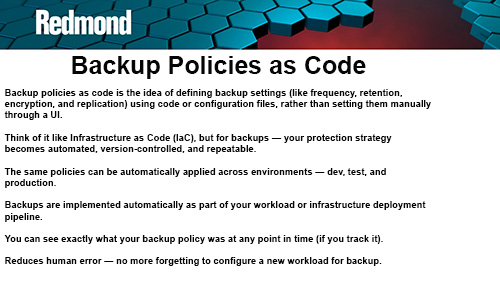News
Why Backup Policies as Code Is Becoming a Cloud Essential
Veteran technologist Brien Posey used his session at today's "Cloud Native Backup Strategies for AWS and Azure" summit to spotlight a shift in how organizations approach data protection. While much of the discussion covered cloud-native architectures, scalability challenges, and evolving threat models, one theme stood out as foundational for cloud operations: treating backup settings and behaviors as code.
 "Backup policies as code is really not all that different from infrastructure as code. It's the idea of defining your backup settings through code rather than setting it all manually."
"Backup policies as code is really not all that different from infrastructure as code. It's the idea of defining your backup settings through code rather than setting it all manually."
Brien Posey, Microsoft MVP
His presentation is being made available for on-demand replay by the summit sponsor, Druva.
Posey, a longtime technologist, freelance author and 22-time former Microsoft MVP, explained that modern cloud environments scale too quickly and change too often for manual configuration to keep pace. He positioned backup policies as code as an answer to that challenge, aligning protection with the same automation principles used to deploy infrastructure and applications.
What Backup Policies as Code Means
Posey described backup policies as code as the practice of defining protection settings through configuration files rather than the traditional point-and-click interface.
 [Click on image for larger view.] Backup Policies as Code.
[Click on image for larger view.] Backup Policies as Code.
He framed it as a direct parallel to infrastructure automation: "Backup policies as code is really not all that different from infrastructure as code. It's the idea of defining your backup settings through code rather than setting it all manually."
He noted that these definitions typically cover details such as frequency, retention, encryption, and replication. Because they are expressed in code, they become version-controlled, repeatable, and transparent. Posey emphasized how this supports accountability, explaining, "you can see exactly what your backup policy was at any given time. You can go back and look at what a policy used to be."
Consistent Protection Across Environments
One of the recurring challenges in hybrid environments is ensuring that protections are applied uniformly. Posey tied policies as code directly to consistency across development, testing, and production systems. As he put it, "the same policy can be applied in development that can be applied in testing and in production."
This approach removes the variability that often results from manual configuration, especially in organizations juggling multiple cloud platforms or shifting workloads across them. With protection embedded in code rather than added after deployment, teams eliminate the need to remember to configure backups manually for each workload.
Reducing Human Error and Integrating with Deployment Pipelines
Posey highlighted human error as one of the most persistent threats to backup reliability, and he pointed to automation as the clearest path to mitigation. In the transcript he stressed, "when you do things manually, there's always the possibility for someone to forget something."
He explained that policy-driven automation can bind backups directly to workload creation. As soon as a resource is deployed, the protection policy applies automatically, removing the need for manual follow-up steps. Posey noted, "you don't have to manually configure those backups because it's automatically handled through policy. When you create a workload, it's backed up automatically."
This also aligns backup behavior with DevOps processes, allowing organizations to treat protection as part of the same repeatable toolchain used for infrastructure and application deployment.
Supporting Portability and Transparency
Because backup policies defined as code are platform-agnostic, they help reduce the risk of vendor-specific lock-in. Posey connected this to organizations operating in hybrid or multi-cloud environments, where portability and transparency matter as much as recovery speed or storage durability.
Code-based definitions also make audits easier. Teams can track when a policy changed, why it changed, and which version applied at any specific time. Posey emphasized this point repeatedly, explaining that version awareness becomes especially valuable during compliance reviews or after an incident.
Why It Matters Now
Posey's broader message centered on modernization. While many organizations can technically extend their existing backup tools into the cloud, he cautioned against assuming that traditional workflows will scale. As he put it in another portion of the session, legacy approaches often replicate the same operational challenges in the cloud but "now with added cloud costs."
Backup policies as code, he argued, give organizations a modernization path that strengthens consistency, reduces errors, and integrates data protection directly into how modern cloud environments operate.
And More
Posey had much more to say on this topic and many others, and again, it's being made available for on-demand replay.
While replays are convenient and informative -- especially up-to-date sessions that just concluded -- attending live events offers advantages, including the ability to ask specific implementation questions and receive guidance in real time. With that in mind, here are some upcoming online webcasts from
RedmondMag, with Pacific time zone start times noted:
About the Author
David Ramel is an editor and writer at Converge 360.